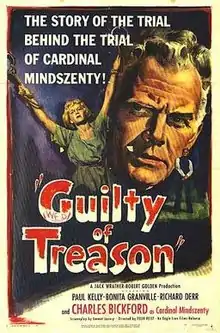Guilty of Treason
Guilty of Treason is a 1950 American drama film directed by Felix E. Feist and starring Charles Bickford, Bonita Granville and Paul Kelly. Also known by the alternative title Treason, it is an anti-communist and anti-Soviet film about the story of József Mindszenty, a Roman Catholic cardinal from Hungary.[1] Mindszenty spoke out against the Nazi occupation of his country during World War II, as well as the later Communist regime. Because of his opposition to the Soviet regime, Mindszenty was arrested and tortured. After his release, he took refuge in the US Embassy in Budapest for many years, maintaining his support for the Hungarians who wanted an end to the Russian occupation.
| Guilty of Treason | |
|---|---|
 | |
| Directed by | Felix E. Feist |
| Produced by | Robert Golden Jack Wrather |
| Written by | Emmet Lavery |
| Starring | Charles Bickford Bonita Granville Paul Kelly Richard Derr |
| Music by | Emil Newman Hugo Friedhofer |
| Cinematography | John L. Russell |
| Edited by | Walter A. Thompson |
Production company | Freedom Productions |
| Distributed by | Eagle-Lion Films |
Release date |
|
Running time | 86 minutes |
| Country | United States |
| Language | English |
Synopsis
The film uses the framing device of a speech to members of the Overseas Press Club of America by a journalist who has just returned from Budapest where he witnessed the treason trial of Mindszenty. He also tells the story of Stephanie Varna, a young teacher who decides to stake a moral stand against Communism despite her love for a Russian officer.
Production
The film was inspired by the book As We See Russia written by members of the Overseas Press Club. It was produced by the Anglo-American company Eagle-Lion. Art Direction was by the German emigre Rudi Feld. It was part of a cycle of anti-communist British and American films released in the late 1940s and early 1950s as the Cold War intensified. Mindszenty's story was portrayed again in the 1955 British film The Prisoner.
Main cast
- Charles Bickford as Joszef Cardinal Mindszenty
- Bonita Granville as Stephanie Varna
- Paul Kelly as Tom Kelly
- Richard Derr as Colonel Aleksandr Melnikov
- Roland Winters as Commissar Belov
- Berry Kroeger as Colonel Timar
- John Banner as Doctor Szandor Deste
- Alfred Linder as Janos
- Thomas Browne Henry as Colonel Gabriel Peter
- Nestor Paiva as Matyas Rakosi
- Morgan Farley as Doctor
- Lisa Howard as Soviet Official
- Elisabeth Risdon as Mindszenty's mother
Bibliography
- Shaw, Tony. Hollywood's Cold War. Edinburgh University Press, 2007.
References
- Shaw p.110
External links
- Guilty of Treason at IMDb
- Guilty of Treason at Rotten Tomatoes

- Guilty of Treason at the American Film Institute Catalog